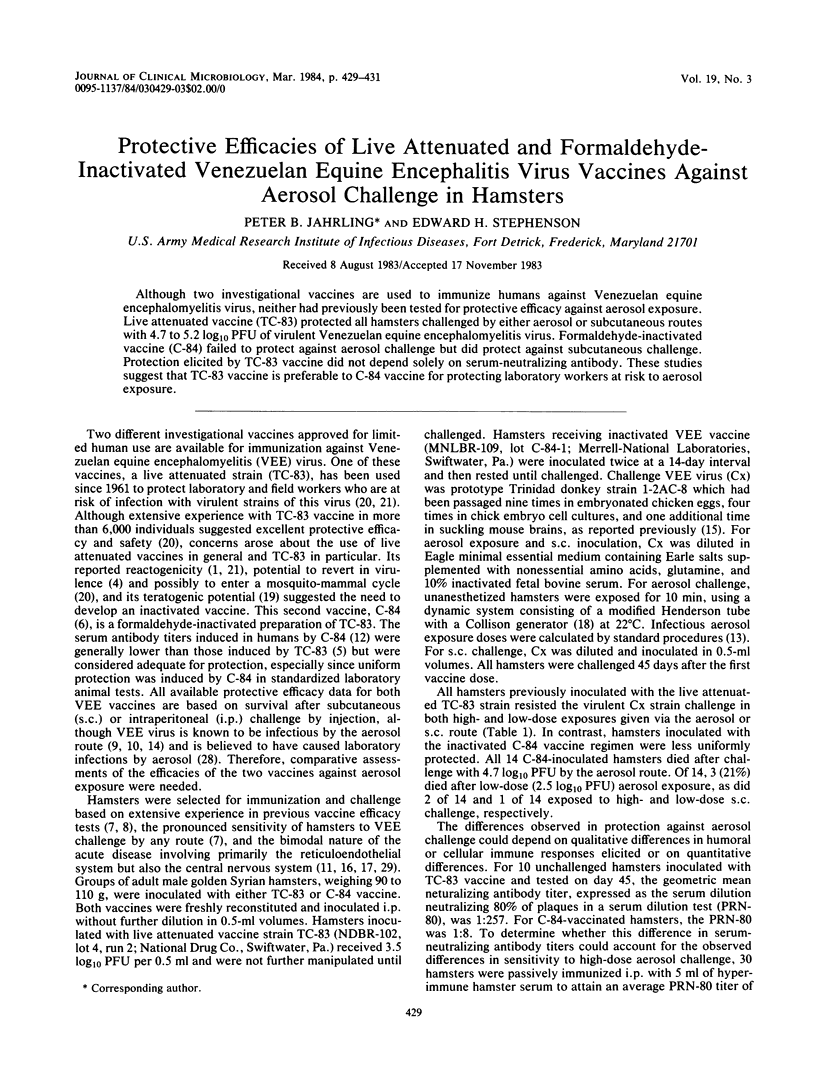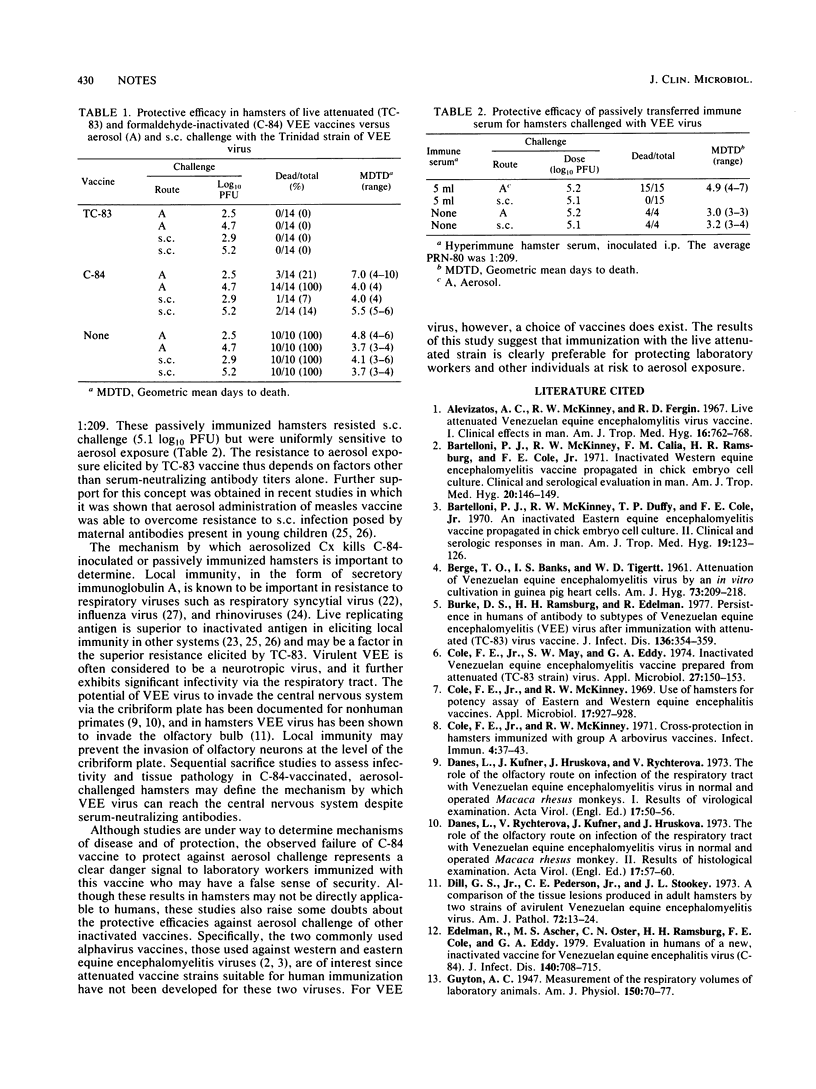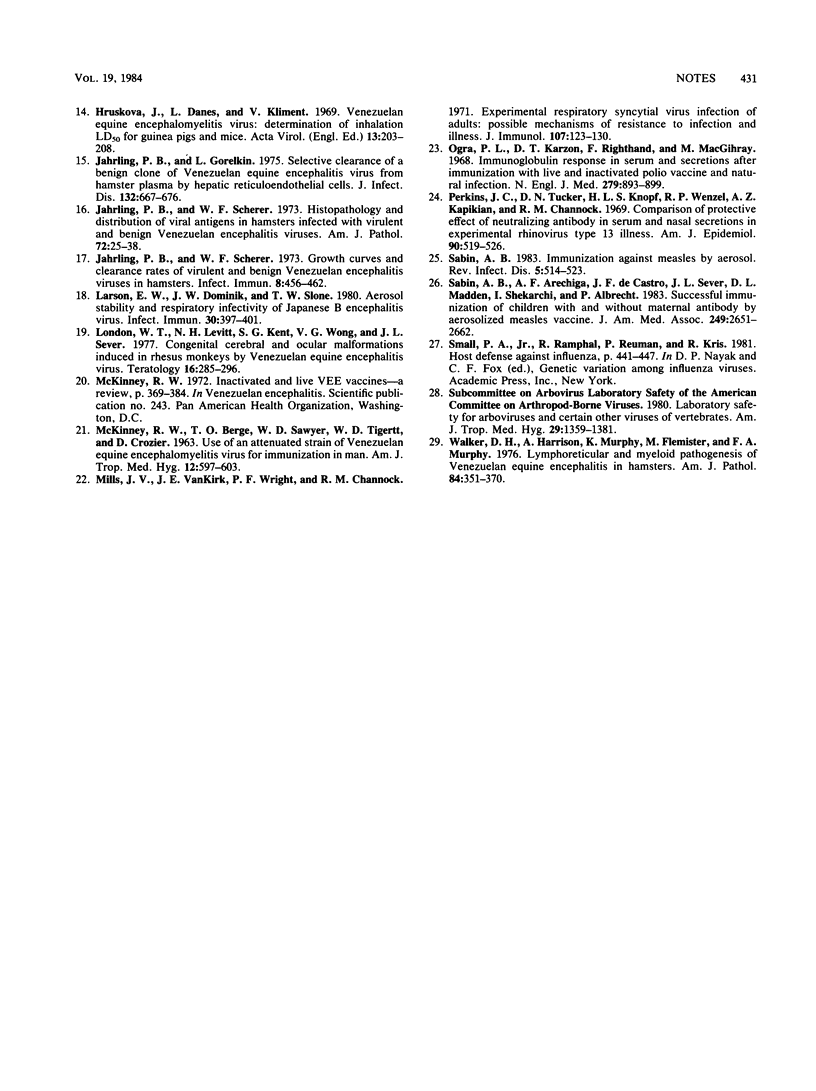Abstract
Although two investigational vaccines are used to immunize humans against Venezuelan equine encephalomyelitis virus, neither had previously been tested for protective efficacy against aerosol exposure. Live attenuated vaccine (TC-83) protected all hamsters challenged by either aerosol or subcutaneous routes with 4.7 to 5.2 log10 PFU of virulent Venezuelan equine encephalomyelitis virus. Formaldehyde-inactivated vaccine (C-84) failed to protect against aerosol challenge but did protect against subcutaneous challenge. Protection elicited by TC-83 vaccine did not depend solely on serum-neutralizing antibody. These studies suggest that TC-83 vaccine is preferable to C-84 vaccine for protecting laboratory workers at risk to aerosol exposure.
Full text
PDF


Selected References
These references are in PubMed. This may not be the complete list of references from this article.
- Alevizatos A. C., McKinney R. W., Feigin R. D. Live, attenuated Venezuelan equine encephalomyelitis virus vaccine. I. Clinical effects in man. Am J Trop Med Hyg. 1967 Nov;16(6):762–768. [PubMed] [Google Scholar]
- Bartelloni P. J., McKinney R. W., Calia F. M., Ramsburg H. H., Cole F. E., Jr Inactivated western equine encephalomyelitis vaccine propagated in chick embryo cell culture. Clinical and serological evaluation in man. Am J Trop Med Hyg. 1971 Jan;20(1):146–149. doi: 10.4269/ajtmh.1971.20.146. [DOI] [PubMed] [Google Scholar]
- Bartelloni P. J., McKinney R. W., Duffy T. P., Cole F. E., Jr An inactivated eastern equine encephalomyelitis vaccine propagated in chick-embryo cell culture. II. Clinical and serologic responses in man. Am J Trop Med Hyg. 1970 Jan;19(1):123–126. doi: 10.4269/ajtmh.1970.19.123. [DOI] [PubMed] [Google Scholar]
- Burke D. S., Ramsburg H. H., Edelman R. Persistence in humans of antibody to subtypes of Venezuelan equine encephalomyelitis (VEE) virus after immunization with attenuated (TC-83) VEE virus vaccine. J Infect Dis. 1977 Sep;136(3):354–359. doi: 10.1093/infdis/136.3.354. [DOI] [PubMed] [Google Scholar]
- Cole F. E., Jr, May S. W., Eddy G. A. Inactivated Venezuelan equine encephalomyelitis vaccine prepared from attenuated (TC-83 strain) virus. Appl Microbiol. 1974 Jan;27(1):150–153. doi: 10.1128/am.27.1.150-153.1974. [DOI] [PMC free article] [PubMed] [Google Scholar]
- Cole F. E., Jr, McKinney R. W. Cross-protection in hamsters immunized with group A arbovirus vaccines. Infect Immun. 1971 Jul;4(1):37–43. doi: 10.1128/iai.4.1.37-43.1971. [DOI] [PMC free article] [PubMed] [Google Scholar]
- Cole F. E., Jr, McKinney R. W. Use of hamsters of potency assay of Eastern and Western equine encephalitis vaccines. Appl Microbiol. 1969 Jun;17(6):927–928. doi: 10.1128/am.17.6.927-928.1969. [DOI] [PMC free article] [PubMed] [Google Scholar]
- Danes L., Kufner J., Hrusková J., Rychterová V. The role of the olfactory route on infection of the respiratory tract with Venezuelan equine encephalomyelitis virus in normal and operated Macaca rhesus monkeys. I. Results of virological examination. Acta Virol. 1973 Jan;17(1):50–56. [PubMed] [Google Scholar]
- Danes L., Rychterová V., Kufner J., Hrusková J. The role of the olfactory route on infection of the respiratory tract with Venezuelan equine encephalomyelitis virus in normal and operated Macaca rhesus monkeys. II. Results of histological examination. Acta Virol. 1973 Jan;17(1):57–60. [PubMed] [Google Scholar]
- Dill G. S., Jr, Pederson C. E., Jr, Stookey J. L. A comparison of the tissue lesions produced in adult hamsters by two strains of avirulent Venezuelan equine encephalomyelitis virus. Am J Pathol. 1973 Jul;72(1):13–24. [PMC free article] [PubMed] [Google Scholar]
- Edelman R., Ascher M. S., Oster C. N., Ramsburg H. H., Cole F. E., Eddy G. A. Evaluation in humans of a new, inactivated vaccine for Venezuelan equine encephalitis virus (C-84). J Infect Dis. 1979 Nov;140(5):708–715. doi: 10.1093/infdis/140.5.708. [DOI] [PubMed] [Google Scholar]
- Hrusková J., Danes L., Kliment V. Venezuelan equine encephalomyelitis virus: determination of inhalation LD50 for guinea pigs and mice. Acta Virol. 1969 May;13(3):203–208. [PubMed] [Google Scholar]
- Jahrling P. B., Gorelkin L. Selective clearance of a benign clone of Venezuelan equine encephalitis virus from hamster plasma by hepatic reticuloendothelial cells. J Infect Dis. 1975 Dec;132(6):667–676. doi: 10.1093/infdis/132.6.667. [DOI] [PubMed] [Google Scholar]
- Jahrling P. B., Scherer F. Histopathology and distribution of viral antigens in hamsters infected with virulent and benign Venezuelan encephalitis viruses. Am J Pathol. 1973 Jul;72(1):25–38. [PMC free article] [PubMed] [Google Scholar]
- Jahrling P. B., Scherer W. F. Growth curves and clearance rates of virulent and benign Venezuelan encephalitis viruses in hamsters. Infect Immun. 1973 Sep;8(3):456–462. doi: 10.1128/iai.8.3.456-462.1973. [DOI] [PMC free article] [PubMed] [Google Scholar]
- Larson E. W., Dominik J. W., Slone T. W. Aerosol stability and respiratory infectivity of japanese B encephalitis virus. Infect Immun. 1980 Nov;30(2):397–401. doi: 10.1128/iai.30.2.397-401.1980. [DOI] [PMC free article] [PubMed] [Google Scholar]
- London W. T., Levitt N. H., Kent S. G., Wong V. G., Sever J. L. Congenital cerebral and ocular malformations induced in rhesus monkeys by Venezuelan equine encephalitis virus. Teratology. 1977 Dec;16(3):285–285. doi: 10.1002/tera.1420160307. [DOI] [PubMed] [Google Scholar]
- MCKINNEY R. W., BERGE T. O., SAWYER W. D., TIGERTT W. D., CROZIER D. USE OF AN ATTENUATED STRAIN OF VENEZUELAN EQUINE ENCEPHALOMYELITIS VIRUS FOR IMMUNIZATION IN MAN. Am J Trop Med Hyg. 1963 Jul;12:597–603. doi: 10.4269/ajtmh.1963.12.597. [DOI] [PubMed] [Google Scholar]
- Mills J., 5th, Van Kirk J. E., Wright P. F., Chanock R. M. Experimental respiratory syncytial virus infection of adults. Possible mechanisms of resistance to infection and illness. J Immunol. 1971 Jul;107(1):123–130. [PubMed] [Google Scholar]
- Perkins J. C., Tucker D. N., Knopf H. L., Wenzel R. P., Kapikian A. Z., Chanock R. M. Comparison of protective effect of neutralizing antibody in serum and nasal secretions in experimental rhinovirus type 13 illness. Am J Epidemiol. 1969 Dec;90(6):519–526. doi: 10.1093/oxfordjournals.aje.a121098. [DOI] [PubMed] [Google Scholar]
- Sabin A. B., Flores Arechiga A., Fernández de Castro J., Sever J. L., Madden D. L., Shekarchi I., Albrecht P. Successful immunization of children with and without maternal antibody by aerosolized measles vaccine. I. Different results with undiluted human diploid cell and chick embryo fibroblast vaccines. JAMA. 1983 May 20;249(19):2651–2662. [PubMed] [Google Scholar]
- Sabin A. B. Immunization against measles by aerosol. Rev Infect Dis. 1983 May-Jun;5(3):514–523. doi: 10.1093/clinids/5.3.514. [DOI] [PubMed] [Google Scholar]
- Walker D. H., Harrison A., Murphy K., Flemister M., Murphy F. A. Lymphoreticular and myeloid pathogenesis of Venezuelan equine encephalitis in hamsters. Am J Pathol. 1976 Aug;84(2):351–370. [PMC free article] [PubMed] [Google Scholar]


